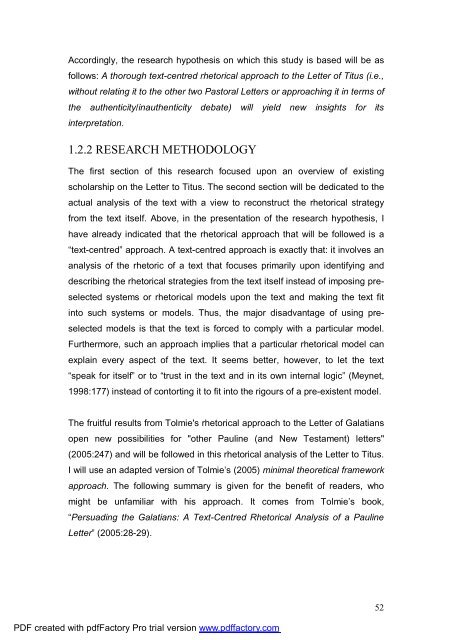A Text centred rhetorical analysis of Paul's Letter to Titus
A Text centred rhetorical analysis of Paul's Letter to Titus
A Text centred rhetorical analysis of Paul's Letter to Titus
Create successful ePaper yourself
Turn your PDF publications into a flip-book with our unique Google optimized e-Paper software.
Accordingly, the research hypothesis on which this study is based will be as<br />
follows: A thorough text-<strong>centred</strong> <strong>rhe<strong>to</strong>rical</strong> approach <strong>to</strong> the <strong>Letter</strong> <strong>of</strong> <strong>Titus</strong> (i.e.,<br />
without relating it <strong>to</strong> the other two Pas<strong>to</strong>ral <strong>Letter</strong>s or approaching it in terms <strong>of</strong><br />
the authenticity/inauthenticity debate) will yield new insights for its<br />
interpretation.<br />
1.2.2 RESEARCH METHODOLOGY<br />
The first section <strong>of</strong> this research focused upon an overview <strong>of</strong> existing<br />
scholarship on the <strong>Letter</strong> <strong>to</strong> <strong>Titus</strong>. The second section will be dedicated <strong>to</strong> the<br />
actual <strong>analysis</strong> <strong>of</strong> the text with a view <strong>to</strong> reconstruct the <strong>rhe<strong>to</strong>rical</strong> strategy<br />
from the text itself. Above, in the presentation <strong>of</strong> the research hypothesis, I<br />
have already indicated that the <strong>rhe<strong>to</strong>rical</strong> approach that will be followed is a<br />
“text-<strong>centred</strong>” approach. A text-<strong>centred</strong> approach is exactly that: it involves an<br />
<strong>analysis</strong> <strong>of</strong> the rhe<strong>to</strong>ric <strong>of</strong> a text that focuses primarily upon identifying and<br />
describing the <strong>rhe<strong>to</strong>rical</strong> strategies from the text itself instead <strong>of</strong> imposing pre-<br />
selected systems or <strong>rhe<strong>to</strong>rical</strong> models upon the text and making the text fit<br />
in<strong>to</strong> such systems or models. Thus, the major disadvantage <strong>of</strong> using pre-<br />
selected models is that the text is forced <strong>to</strong> comply with a particular model.<br />
Furthermore, such an approach implies that a particular <strong>rhe<strong>to</strong>rical</strong> model can<br />
explain every aspect <strong>of</strong> the text. It seems better, however, <strong>to</strong> let the text<br />
“speak for itself” or <strong>to</strong> “trust in the text and in its own internal logic” (Meynet,<br />
1998:177) instead <strong>of</strong> con<strong>to</strong>rting it <strong>to</strong> fit in<strong>to</strong> the rigours <strong>of</strong> a pre-existent model.<br />
The fruitful results from Tolmie's <strong>rhe<strong>to</strong>rical</strong> approach <strong>to</strong> the <strong>Letter</strong> <strong>of</strong> Galatians<br />
open new possibilities for "other Pauline (and New Testament) letters"<br />
(2005:247) and will be followed in this <strong>rhe<strong>to</strong>rical</strong> <strong>analysis</strong> <strong>of</strong> the <strong>Letter</strong> <strong>to</strong> <strong>Titus</strong>.<br />
I will use an adapted version <strong>of</strong> Tolmie’s (2005) minimal theoretical framework<br />
approach. The following summary is given for the benefit <strong>of</strong> readers, who<br />
might be unfamiliar with his approach. It comes from Tolmie’s book,<br />
“Persuading the Galatians: A <strong>Text</strong>-Centred Rhe<strong>to</strong>rical Analysis <strong>of</strong> a Pauline<br />
<strong>Letter</strong>” (2005:28-29).<br />
PDF created with pdfFac<strong>to</strong>ry Pro trial version www.pdffac<strong>to</strong>ry.com<br />
52

















